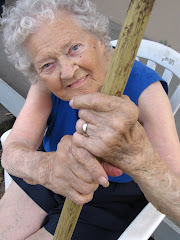This is a photo of Mom last year when she got shingles on her face and head. This is after 2 days of what the nursing home called a "rash" and it got much worse. The nursing home sent her to the doctor thinking she needed antibiotics but he immediately noticed that there were specific linear boundaries to it and diagnosed shingles. When someone has shingles on the head, s/he may get pus-filled blisters that ooze, like canker sores on ones lip but they are in a broader area within a specific boundary. Don't touch the ooze!! It's grose but it's full of the shingles virus and you could contract or spread it.
In mom's case it's like someone drew a perfectly level line starting just under her nose and around to her left ear then on to the back of her head. From that point the line went over the very middle of her head and down her nose. Think of a ball and the same lines; it's like 1/4 of the ball was covered in sores.
She had shingles years ago and they were in a very specific strip from the middle of her back around her waist to the left and across the front of her body. Shingles infects the nerve endings in the skin and the patterns are very specific and linear - it's very geometric. In men shingles often forms on the left chest, back and shoulder. The pain is quite severe and often the initial fear is a heart attack but it's on the surface not a deep pain so that's how you can tell the difference.
I would also note Mom's eye and the eyebrow. This area was swollen and painful overall. Her eyes are blue and usually clear but the infected eye turned right turquoise and the white part got yellowish. She had many sores in her eye brow and into her hair line.
A year later, I notice that her forehead is still red and blotchy and the hair in the infected area is thinner. She's 93 so part of it could be her age but I can't help wonder if the sores helped increase the thinning.
Shingles on my head, shingles on the head, shingles on the face, how can i tell if i have shingles? How can i tell if mom has shingles? how can i tell if dad has shingles?




